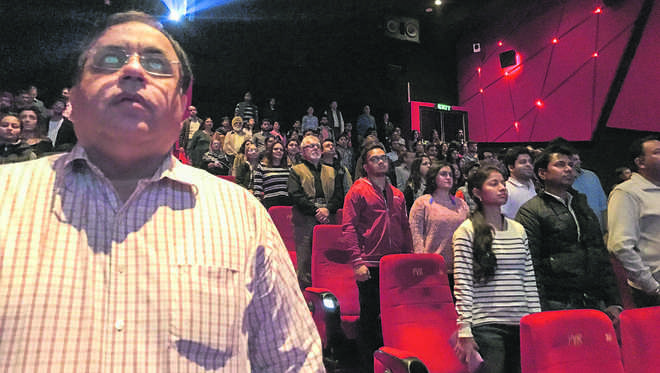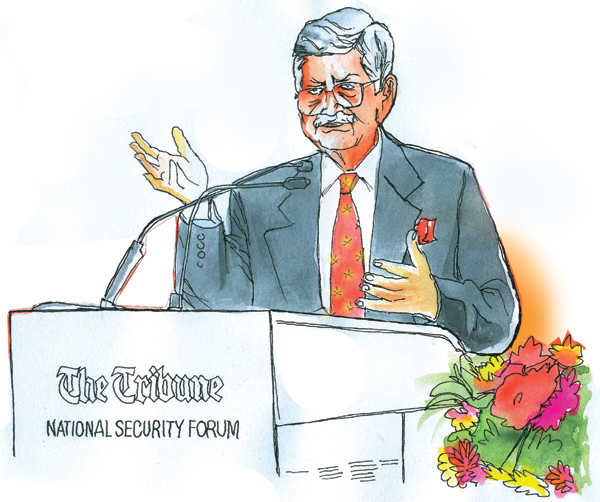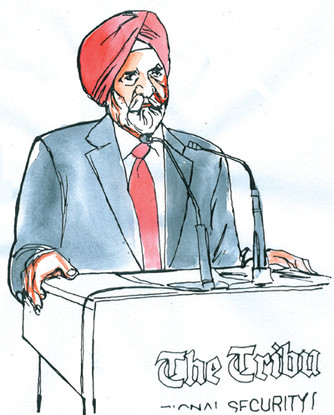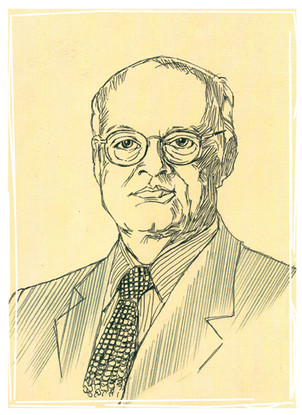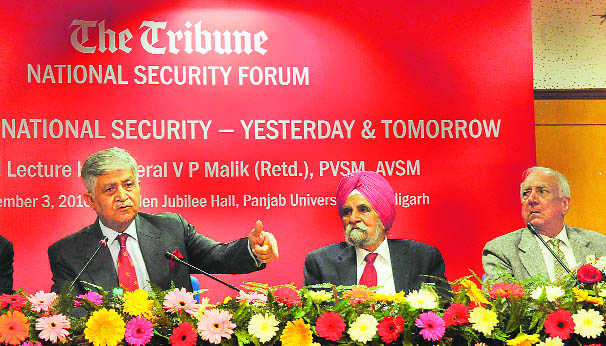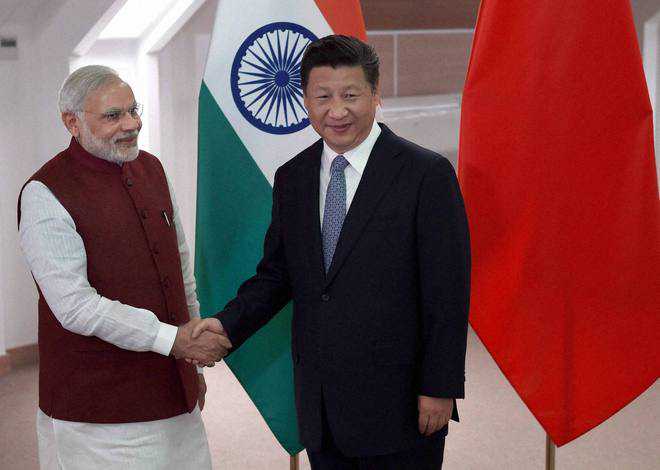Sanjeev Sharma
Tribune News Service
New Delhi, December 8
With cash crunch persisting even a month after the November 8 demonetisation decision, the government today announced a slew of measures to incentivise cashless payments. The 11 measures listed include discounts on purchase of fuel, insurance policies and free railway accidental insurance cover for payments made using digital mode, including debit and credit cards, mobile phone applications and e-wallets.Announcing the package, Finance Minister Arun Jaitley said following the cancellation of the legal tender character of old Rs 500 and Rs 1,000 notes, there had been a surge in digital transactions and the measures announced today would further accelerate the process.“We were using excessive amount of cash and very limited amount of digital transactions till November 8,” Jaitley said, adding the cost of transacting in cash had to be borne by the economy.Jaitley said public sector oil marketing companies would offer a discount at the rate of 0.75 per cent of the sale price on purchase of petrol and diesel if payment was made through digital means. The incentive scheme had the potential to shift at least 30 per cent more customers to digital means, which would further reduce the cash requirement of Rs 2 lakh crore per year at petrol stations, he said.Nearly 4.5 crore customers buy petrol and diesel at fuel stations every day, resulting in estimated daily sale of Rs 1,800 crore. Nearly 20 per cent of the payments are made through digital means.After demonetisation, digital payments have jumped to 40 per cent and cash transactions of Rs 360 crore per day have got shifted to cashless transaction methods.For insurance policies, a discount of 10 per cent and 8 per cent, respectively, will be offered in case of general and life insurance for buying new policies or paying premium online through the customer portals of PSU insurance companies.All railway passengers buying online ticket will get free accidental insurance cover of up to Rs 10 lakh. In addition, passengers using digital mode to pay for railway catering, accommodation, retiring room will get 5 per cent discount.Nearly 14 lakh railway passengers buy tickets every day, out of which 58 per cent are bought online. It is expected another 20 per cent passengers may shift to digital payment methods of buying railway tickets. Nearly 11 lakh passengers per day will be covered under the accidental insurance scheme. For payment at toll plazas on national highways using RFID card/Fast Tags, a discount of 10 per cent will be available to users in 2016-17.To expand digital payment infrastructure in the rural areas, the Centre through NABARD will extend financial support to eligible banks for deployment of 2 point of sales (POS) devices each in 1 lakh villages with population of less than 10,000.Jaitley said it would benefit farmers of one lakh villages covering nearly 75 crore people. The government will also support rural regional banks and cooperative banks to issue “Rupay Kisan Cards”.
Make card OR ONLINE payment, stand to gain…
- 0.75% discount when buying petrol and diesel
- 0.5% discount for seasonal suburban railway tickets from Jan
- 5% discount for railways catering, accommodation, retiring room
- 10% discount if buying, paying premium for PSU general insurance
- 8% discount if buying, paying premium for PSU life insurance
- Rs 10 lakh accident insurance cover if online rly ticket booking
- POS machines for villages with 10K population, 1 lakh selected
- 10% discount for RFID or fastags for highway toll
- Farmers to get Rupay Kisan cards
- Depts to see no transaction fee, MDR charges borne by customers
Transactions up to Rs 2,000: No service tax
- When a customer uses a credit, debit, charge or any other payment card for payment, the merchant is charged certain merchant discount rate (MDR) by the issuing bank. To encourage merchant establishments to accept card payments, the government has waived service tax on transactions up to Rs 2,000.
Rs 90-cr cash, 100-kg gold seized in Chennai
- Chennai: The Income Tax Department raided the premises of businessman Sekhar Reddy and his associate Srinivasa Reddy here and seized Rs 90 crore in cash and 100-kg gold. The raids began in the morning on eight premises here and other places in the state. Out of the total cash seized, around Rs 10 crore was in new currency notes of Rs 2,000. — IANS
Meanwhile, another queue death
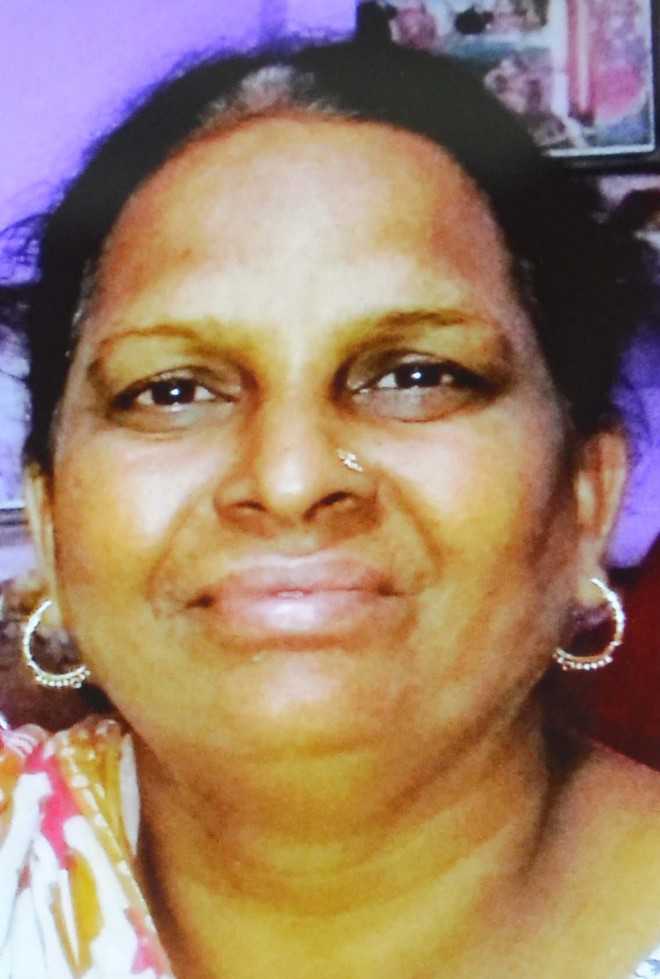
Asha Rani
Nikhil Bhardwaj
Tribune News Service
Ludhiana, December 8
A 48-year-old woman died after she was allegedly pushed by a guard outside a Punjab National Bank branch on the Shingar Cinema road today. The victim had gone there to withdraw cash. The road leading to Samrala chowk remained blocked for hours after her family along with hundreds of residents kept the body outside the bank in protest.Asha Rani of Charan Nagar on Tibba road had been unable to withdraw cash since Monday owing to rush or lack of cash, claimed son Parvinder.“On Wednesday, bank officials gave her a token with the assurance that she would get cash the next day without having to stand in the queue. This morning, she again had to join the queue. As she was about to enter the premises, a guard allegedly pushed her away. She fell down and became unconscious,” alleged Parvinder.Family members took her to a private hospital but the doctors refused to admit her. At CMC , the doctors declared her brought dead.Agitated kin brought the body back to the bank and blocked the road, demanding action against the bank manager and the guard. A posse of police was deployed, even as protesters tried to ransack the bank. Two years ago, the victim had lost her husband in an electrocution incident. Her daughter’s wedding was scheduled for February.
30 days of suffering, and counting
Cash clean-up: Workers losing jobs; business down 40-50 pc; precious man hours being lost in queues
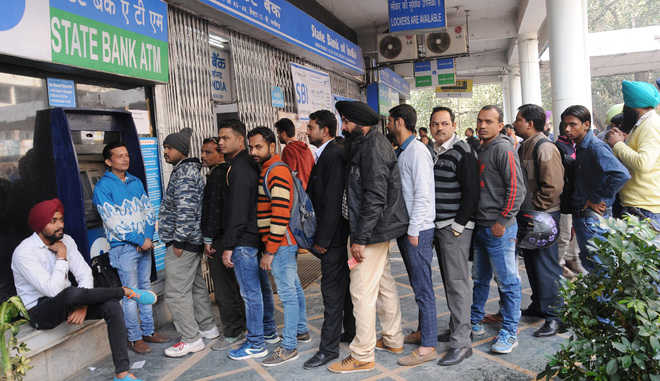
No cash, but there’s a queue: People wait for cash to arrive at an SBI ATM in Sector 17 on Thursday. Tribune photo: Manoj Mahajan P4
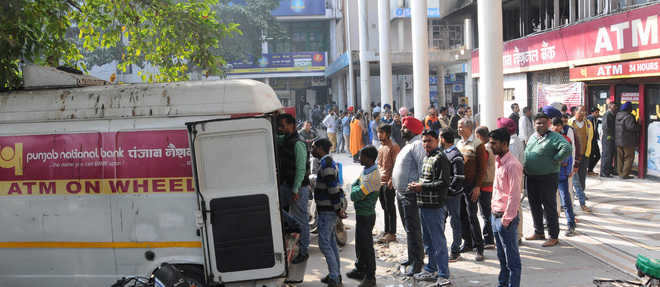
Nitin Jain
Tribune News Service
Chandigarh, December 8
It was this day last month that Prime Minister Narendra Modi dropped the bombshell of demonetising currency notes of Rs 500 and Rs 1,000 denomination.The government may gloat over its decision ostensibly taken to suck out black money but the ground reality remains that people are suffering and the hardest hit are those who are at the bottom rung of the economic ladder.Many a worker has lost jobs, families have gone without food for days, hundreds and thousands of man hours are being lost standing in queues outside banks and ATMs everyday and traders, both big and small, are ruing the fact that their sales are down by 40 to 50 per cent.Rubbing salt on their wounds, banks are refusing to allow them to draw money even up to the ceiling announced by the Central Government. They may not be at fault for the RBI is not able to supply them their requirement of currency but again the harsh reality remains that people cannot lay hands on their hard-earned money they had parked in banks to meet their day-to-day needs.This sums up the sentiment in the tricity one month after the demonetisation announcement made by the Prime Minister.Another major reason behind the public hardship is the Rs 2,000 note, which cannot be used to buy milk, bread, fruits, vegetables or other daily needs.A majority of the vendors and traders refuse to accept the Rs 2,000 note for any purchases below Rs 500 for want of currency notes of smaller denomination.“One month was enough to wipe out the shortage of lower denomination notes in the market but the government has failed miserably,” said an irate Roshan Lal, a retail fruit and vegetable trader in Sector 26.A tea seller in Sector 17, Suresh Kumar, said, “People have stopped having tea and snacks despite winter setting in. Nobody wants to shell out whatever cash he has even after a month.”“Even as the UT Administration is pressing hard for a cashless economy, people have not been so enthusiastic to pay by cards, mobile apps or other e-modes. In the absence of ample smaller denomination currency, we have to daily turn away many customers, who come with a Rs 2,000 note for paying bills ranging between Rs 100 and Rs 500,” said Gurpal Singh, a dhaba owner in Sector 34.A housewife from Panchkula, Rupali Tyagi, who sounded frustrated, said, “Modi had sought 50 days, and now 30 days have passed but the sad part is there has been no significant improvement in the circulation of money.”With serpentine queues outside banks and ATMs refusing to thin out, people have been rendered cashless and are finding it extremely difficult to meet their daily expenses, leave aside making any purchases.A visit to different parts of the tricity this morning revealed that people were still queued up outside banks and ATMs to meet their cash requirements.Upset about banks refusing payments due to the cash crunch, an NRI from the USA, Krishan Lal Aggarwal, said, “For the past four days, I have been returning empty-handed from the Central Bank branch in Sector 22, which runs out of cash each time my turn comes after waiting for over an hour everyday”.“We even stand in long queues outside banks and ATMs where there is no cash hoping that cash may arrive,” rued a student, Amanjot, who was also queued up outside a bank branch in Sector 17.A senior bank officer, who did not wished to be named, said, “Our blood has been sucked by the note ban as we are the ones who are facing the anger and frustration of people everyday despite working overtime for the past 30 days.”An NRI, Aravindakshan, who landed here on Tuesday, said a forex dealer at the airport exchanged his $200 at the rate of Rs 61 per USD against the market rate of over Rs 67. “This shows how forex dealers are also making hay while ‘demonetisation blues shine’,” he rued. Rs 500 note prized possession“It’s been 30 days now, but I haven’t yet seen the new Rs 500 note,” said Aradhika, who was able to withdraw Rs 10,000 on Thursday. She is one of the many who are still vying to lay their hands on the new Rs 500 notes. SBoP DGM Fanish Gupta said due to scarcity, several bank branches were yet to get the new Rs 500 notes. “We have been assured extra new currency on Friday,” he added.
















